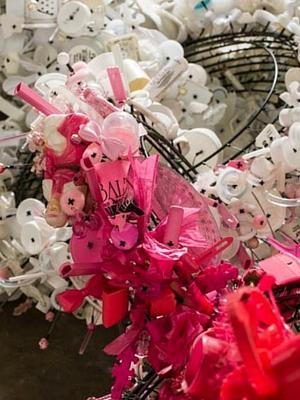Sponsored by the Museum of Fine Arts, Boston. Experience a first-of-its-kind exhibition, “Crafted: Objects in Flux,” that blurs the boundaries of art, craft, and design. The exhibition is on display through January 10, 2016.

Susie Ganch is not only an award-winning artist. She is also a jeweler, geologist, activist, and educator. Ganch is working to raise awareness of ethical mining through her art. “Drag,” her striking, eleven-foot long bracelet, forces viewers to question their habits of consumption as it is comprised of recycled, everyday disposables — from Starbucks cups and lids, to paper towel rolls and plastic spoons.
BostInno caught up with Ganch recently. She filled us in on where her passion for metalsmithing began, her teaching philosophy, and why she is so honored to be featured in “Crafted: Objects in Flux,” at the Museum of Fine Arts, Boston.
Ethan Bukowiec: When did you realize you had a passion for metalsmithing?
Susie Ganch: As I was pursuing my degree in geology, I spent a lot of time looking through a microscope, and needed something to offset that time. I thought I would take a fun art class, like a lot of people do. The first day of metalsmithing class, my professor and mentor turned on the torch and it felt like somebody turned a light bulb on in my mind.
EB: How did your geology background combined with your work as a metalsmith play into your role as an activist promoting ethical mining?

SG: One day, it dawned on me that the very thing I refused to do in geology, I was doing in a very different way as a metalsmith.
So, that got me working on figuring out how I could insert my values and my interest into a practice while still making. I didn’t want to be frozen and incapacitated by what I was feeling — I didn’t want to run from it. I wanted to force myself to run to it, and figure out a way to work on it through my practice and through my teaching.
When I started working with Christina Miller and Ethical Metalsmiths, it was like someone handed me this license, and it really drives a large part of my practice. After graduating in 1997 and being in the field, it finally feels like all of these things have converged, and I understand after all of these years how it all flows into me and out of me, and how it all combines in weaves of fabric that I call my practice.
EB: Can you describe the process that went into creating “Drag”?
SG: With the past series of art I created, I was thinking about the interconnected system of the universe and how I could create systems in my own work where the pieces are reliant on each other for the whole piece to function as a unified system.
With “Drag,” it’s all woven together. If you look at the inner structure, it’s basically a chain link that’s growing, and the links are made by steel wire going one direction and bound together by steel cables going in the opposite direction. Everything is held together by tension, and each piece of trash represents connection points on the chain link, so there’s an interconnected system happening within the bracelet that relates back to my older work.
I used trash in creating “Drag” because, a few years ago, I had been generating my own pieces to represent the connection points on the bracelet — cast plastic, enameled copper, lab-grown gems — and at one point I realized that method wasn’t connecting my work to the world outside my studio. So, as I was collecting things from my local community, it dawned on me that there’s stuff out there already, and that stuff is a metaphor, and I should be mining pieces from my own community. That connected me to the world outside my studio.

The piece took me over a year to make and it just evolved over time. After I made “Drag,” I had a photo shoot because I wanted to capture the dynamic between body and object. After I was satisfied with the photo shoot, I finished the piece by adding on another five or six feet so that it could really enhance the drama of the way it would fit in the gallery.
Anchoring it to the wall with such a heavy mount was done on purpose as well. I want people to feel like it is tethered and question whether it is trying to get away or being pulled in. There’s that little bit of ambiguity to it.
EB: How does being featured in an exhibition of the significance of “Crafted” raise awareness for consumption and craft in general?
SG: I think this exhibition is so important and pivotal in many ways. On the level of craft, it challenges cultural notions of what craft is, what craft can be, how craft is made, and what a craft artist thinks.
For instance, hopefully “Drag” makes people think about their habits of consumption. The bracelet is made out of “trash,” and trash is an easy connection to your own habits of consumption, but it speaks about the burden of that complexity of how we’re living today.
EB: Lastly, what is your overall impression of the “Crafted: Objects in Flux” exhibition?
SG: I feel so honored to be in this exhibition and that my work is in conversation with artists whose work I love. The way MFA curator Emily Zilber put “Crafted” together and tied it together for the viewer to walk through is phenomenal.
Want to learn more? Buy your tickets now to hear Susie Ganch speak on Sunday, October 4, at the Museum of Fine Arts, Boston for the Daphne Farago Lecture on Jewelry.
Images via Museum of Fine Arts, Boston

